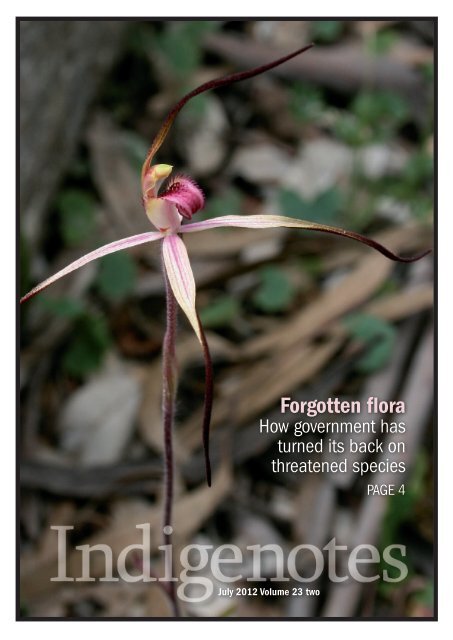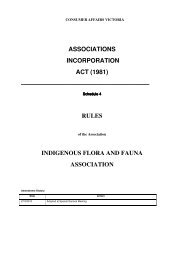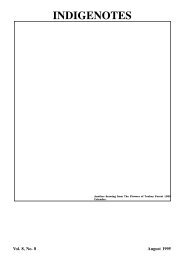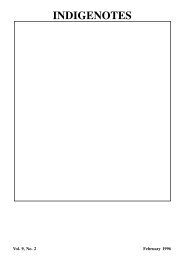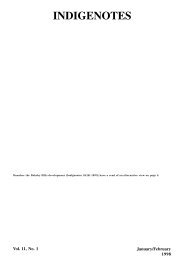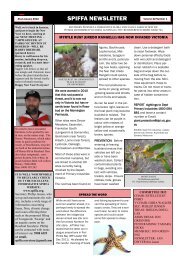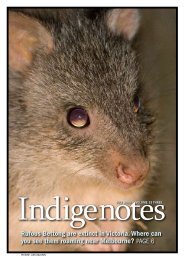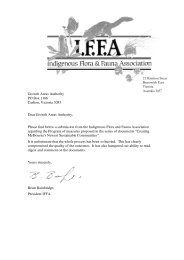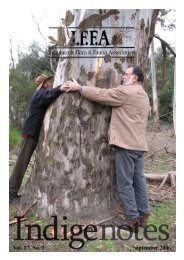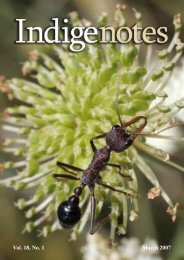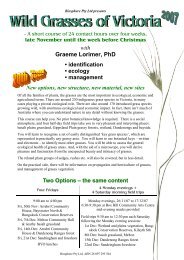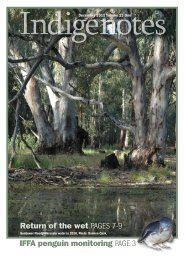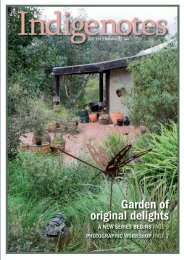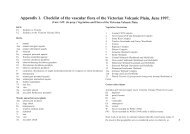Indigenotes - Indigenous Flora and Fauna Association
Indigenotes - Indigenous Flora and Fauna Association
Indigenotes - Indigenous Flora and Fauna Association
Create successful ePaper yourself
Turn your PDF publications into a flip-book with our unique Google optimized e-Paper software.
Forgotten flora<br />
How government has<br />
turned its back on<br />
threatened species<br />
PAGE 4<br />
INDIGENOTES VOLUME 23 NUMBER 2<br />
July 2012 Volume 23 two
Dianella being planted at Laverton Grassl<strong>and</strong>s to provide food for the bee that<br />
pollinates Diuris fragrantissima. Photo: Alex Smart.<br />
Orchids pictured on this <strong>and</strong> the following page are currently grown at the Horsham<br />
DSE Lab. All are threatened at national <strong>and</strong> state levels <strong>and</strong> listed under the<br />
Victorian <strong>Flora</strong> <strong>and</strong> <strong>Fauna</strong> Guarantee Act.<br />
IFFA OUTING Bush Heritage<br />
Nardoo Hills Reserve<br />
19 August 2012 10.30am-3pm<br />
Non-members welcome<br />
Come <strong>and</strong> join Bush Heritage’s Victorian Reserves Manager<br />
Jeroen van Veen for an exclusive visit to Nardoo Hills Reserve.<br />
This 817 ha reserve supports a large diversity of vegetation<br />
communities including grey box grassy woodl<strong>and</strong>, boxironbark<br />
<strong>and</strong> mallee, providing vital habitats for a range of<br />
wildlife. Since Bush Heritage acquired the first property in<br />
2004 <strong>and</strong> actively managed it for conservation outcomes,<br />
the transformation has been remarkable.<br />
After an initial introduction over a cup of tea we will set off<br />
on foot to explore more of this wonderful property; taking in<br />
some of the key features <strong>and</strong> management practices. The<br />
terrain is rather rocky <strong>and</strong> hilly but the pace will be gentle<br />
to allow for plenty of looking <strong>and</strong> talking. We are likely to<br />
cover around 3-5km. Don’t forget to bring your cameras <strong>and</strong><br />
binoculars.<br />
Visit details: 10.30am – 3pm at reserve,<br />
reachable by 2WD, ~210km NW of<br />
Melbourne (allow 3hrs driving time),<br />
nearest town is Wedderburn 12km.<br />
We’ll organise a carpool for people who<br />
are without transport. Composting<br />
toilet on site. The cost of the tour will<br />
be a voluntary donation to the Bush<br />
Heritage Reserve.<br />
You will need: BYO all food <strong>and</strong><br />
drinks, reasonable level of fitness/<br />
mobility, arrange own transport to <strong>and</strong><br />
from the reserve (or carpool), wear<br />
comfortable clothing <strong>and</strong> sturdy foot<br />
wear for off-track walking.<br />
For bookings call Fam Charko<br />
04 02519124 or email:<br />
bookings@iffa.org.au.<br />
Please state your name, phone number, number of people<br />
attending <strong>and</strong> if you need a spot in the carpool. Some<br />
members may be staying overnight nearby; you may be<br />
interested too.<br />
5<br />
President’s letter<br />
1<br />
1 Diuris fragrantissima, Sunshine Diuris,<br />
intended for grassl<strong>and</strong>s on the edge of<br />
Melbourne. Photo: Alex Smart.<br />
In early May IFFA took part in a deputation to the<br />
Shadow Minister for the Environment, Lisa Neville.<br />
We joined concerned members of the public to express<br />
concern at the dismissal of Threatened Species Officers by the<br />
State Government under Ted Baillieu.<br />
In recent months IFFA has made a number of submissions<br />
to the State Government advising our objection to changes<br />
being made in l<strong>and</strong> management <strong>and</strong> species conservation.<br />
We are aware of further troubling proposals in the near future.<br />
There are many dedicated environmental advocacy groups;<br />
why should IFFA engage in political process?<br />
To put it simply, flora <strong>and</strong> fauna doesn’t have a vote, our<br />
members do.<br />
What will be the result of the dismissal of DSE <strong>and</strong> DPI<br />
officers?<br />
Loss of experienced officers contributes to<br />
scientific amnesia<br />
Results of long-term monitoring are crucial to virtually<br />
all threatened species conservation programs. Effective<br />
monitoring programs combine scientific rigour,<br />
meticulous record keeping <strong>and</strong> effective sharing of results<br />
in recognised forums. It is a skill-set that takes years to<br />
develop <strong>and</strong> will need to be redeveloped under a<br />
future government that recognizes the state’s<br />
moral <strong>and</strong> legal obligations to biodiversity<br />
conservation. What a waste.<br />
Lost support for volunteers<br />
The expertise <strong>and</strong> consistency of these officers<br />
supported <strong>and</strong> orchestrated volunteers who give massively<br />
of their time <strong>and</strong> energy. This ‘multiplier effect’ is apparently<br />
unrecognised by the recent cuts.<br />
CONTINUED PAGE 3<br />
Cover image<br />
The C<strong>and</strong>y Spider-orchid, Caladenia versicolor.<br />
Photo David Pitts.<br />
2<br />
INDIGENOUS FLORA AND FAUNA ASSOCIATION INC
2 3 4<br />
2 Caladenia hastata, Mellblom’s Spiderorchid.<br />
Photo: Len Carrigan.<br />
3 Caladenia xanthochila, Yellow-lip Spiderorchidwhich.<br />
Photo: Len Carrigan.<br />
What if flora <strong>and</strong> fauna had a vote?<br />
We have been repeatedly assured these cuts will not affect<br />
‘front-line workers’<br />
For Victoria’s flora <strong>and</strong> fauna, the threatened species officers<br />
are the ‘front line’ workers. Job losses are tragic for individuals<br />
but for endangered flora <strong>and</strong> fauna, such chopping <strong>and</strong><br />
changing can be terminal. Many species now rely on consistent<br />
effort to maintain <strong>and</strong> recover their habitats.<br />
Threatened species projects inspire hope<br />
<strong>and</strong> care for our environment’s future<br />
The genuine gains these projects achieve energise the public<br />
in the face of seemingly endless news of ecological decline.<br />
IFFA members are intensely concerned about these changes<br />
<strong>and</strong> related ones such as the starvation of our reserve system.<br />
The impact of neglected weed control programs on public l<strong>and</strong><br />
is a perennial issue of particular concern to rural l<strong>and</strong>holders<br />
conservationists alike. Cuts at DSE <strong>and</strong> DPI will starve weed<br />
programs. Timely <strong>and</strong> consistent treatment is essential in weed<br />
programs. Delay can lead to vastly increased expenditure a few<br />
years down the track. This is summed up in the old adage that<br />
‘one years seeds equals seven years weeds’ <strong>and</strong> these shortsighted<br />
cuts are sowing the seeds for years of ‘catch up’.<br />
If you disagree with the direction this government is taking,<br />
what can you do? Here are a few suggestions.<br />
• Identify <strong>and</strong> record the impact of these cuts on your local<br />
environment, local parks <strong>and</strong> volunteer groups.<br />
• Tell your local member of Parliament that you are unhappy<br />
with this direction <strong>and</strong> dem<strong>and</strong> a response. Is the case<br />
‘newsworthy’? Ring up or write to your favourite newspaper.<br />
• Support <strong>and</strong> become active in groups addressing this issue.<br />
• Where these programs impact Nationally listed species <strong>and</strong><br />
communities, make sure your Federal member hears about<br />
it as well as the Federal Minister for the Environment, Tony<br />
Burke.<br />
• If you have worked with any staff that have been let go,<br />
ensure they know that their contribution has been valued.<br />
• Identify your allies, they may be found in unexpected<br />
4 Pterostylis xerophila, Desert Rustyhood.<br />
Photo: Len Carrigan.<br />
5 Thelymitra mackibbinii, Brilliant<br />
Sun-orchid. Photo: Len Carrigan.<br />
places. Many businesses involved in l<strong>and</strong> management will<br />
suffer from the lost support for their industry these cuts<br />
represent.<br />
Finally, remember to ‘nourish the soul’. Find time to be in<br />
nature <strong>and</strong> with friends. Strengthen yourself for your sake <strong>and</strong><br />
for the sake of the environment you are working to protect.<br />
Brian Bainbridge<br />
Further information: http://www.iffa.org.au/backwardsspiral-continues-baillieu-government-axes-threatenedspecies-officers<br />
6<br />
6 Caladenia fulva, Tawny Spider-orchid.<br />
Photo: Len Carrigan.<br />
INDIGENOTES VOLUME 23 NUMBER 2<br />
3
The forgotten flora<br />
How the Baillieu Government has<br />
turned its back on threatened species<br />
We pulled off the dusty track <strong>and</strong> parked the car<br />
under a gnarly young stringybark tree. Before us was<br />
a diverse heathy woodl<strong>and</strong>, alive with the colour of<br />
wildflowers in full spring bloom. In the distance I could see<br />
rugged s<strong>and</strong>stone escarpments, lined with dark stunted trees<br />
<strong>and</strong> ancient boulders.<br />
I was on a day trip in the Black Ranges, a westerly extension<br />
of the Grampians near Cherrypool. My travelling companions<br />
were David Pitts, a biodiversity officer for the DSE <strong>and</strong> Roger,<br />
one of DSE’s natural resource managers. Dave <strong>and</strong> I had spent<br />
the week searching <strong>and</strong> monitoring threatened plant species<br />
as part of Dave’s role with the DSE. Today we had headed<br />
out from our base at Horsham to meet Roger, an expert in<br />
the local country <strong>and</strong> its environment. Roger had seen some<br />
orchids out this way that he thought might interest us.<br />
‘This is the spot’, said Roger, <strong>and</strong> we headed into<br />
the bush. We immediately came across a large patch<br />
of beautiful white spider-orchids. These were the<br />
Large White Spider-orchid (Caladenia venusta),<br />
a species listed as vulnerable in Victoria. At most<br />
places this species has declined substantially, but<br />
here they seemed to be thriving. We found over a<br />
hundred, all in slightly different shades of colours<br />
<strong>and</strong> scattered throughout the bush. But then we<br />
saw an orchid that looked very different. We stooped down<br />
low to have a closer look, <strong>and</strong> became increasingly excited as<br />
we compared it to the Large White’s nearby. It was certainly<br />
different <strong>and</strong> looked suspiciously like the C<strong>and</strong>y Spider-orchid<br />
(Caladenia versicolor) a species only known from one other site<br />
in the world over at Lake Fyans. We stayed at the site for well<br />
over an hour, taking an abundance of photos <strong>and</strong> checking<br />
out other wildflowers <strong>and</strong> birds in the area, before heading<br />
for another site. Later in the day we were to discover several<br />
new populations of the nationally rare Elegant Spider-orchid<br />
(Caladenia formosa) before heading back to camp.<br />
The photos of our unusual orchid were sent to several<br />
experts <strong>and</strong> quickly confirmed as the C<strong>and</strong>y Spider-orchid,<br />
which is listed as threatened under the Victorian <strong>Flora</strong> <strong>and</strong><br />
<strong>Fauna</strong> Guarantee Act, <strong>and</strong> considered endangered by DSE.<br />
It is listed as vulnerable under the Australian Environment<br />
Protection <strong>and</strong> Biodiversity Conservation Act. This population<br />
was the second disjunct population of only two. Over the<br />
next twelve months Dave worked busily on this population<br />
<strong>and</strong> managed to collect enough seed to send to the DSE<br />
laboratory in Horsham. There, Dr Noushka Reiter <strong>and</strong> her<br />
team managed to successfully propagate the species, a huge<br />
break-through in the recovery work. A back-up population<br />
of the plants was now available <strong>and</strong> the species could be reintroduced<br />
into another suitable site if considered appropriate<br />
by the orchid advisory committee.<br />
Sounds inspiring doesn’t it? Well this is where the Baillieu<br />
Government steps in. Several months ago David Pitts,<br />
Noushka Reiter <strong>and</strong> nine other DSE biodiversity officers in<br />
the south-west Victoria region were told to get ready to pack<br />
their bags, as their contracts would not be renewed. The<br />
recovery programs that these dedicated <strong>and</strong> highly trained<br />
staff had been working on for years would now grind to a<br />
halt. What of the seven thous<strong>and</strong> rare orchids sitting in the<br />
Horsham laboratory waiting to be re-introduced to the wild?<br />
‘Who cares?’ seems to be the Baillieu government’s response.<br />
Orchids weren’t the only plants the DSE officers had been<br />
working on either. A large assemblage of nationally endangered<br />
plants had been under their close management, from salt<br />
lake shrubs, wetl<strong>and</strong> herbs to annual grasses. No one is now<br />
available to look after these species in the south-west region,<br />
other than the already over-worked remaining staff.<br />
The Victorian Government has strong legal obligations<br />
to manage our threatened species under global agreements<br />
(the United Nations ‘Convention on Biological Diversity’,<br />
of which Australia is a signatory), National legislation (the<br />
Environment Protection <strong>and</strong> Biodiversity Conservation Act)<br />
What of the seven thous<strong>and</strong> rare orchids<br />
sitting in the Horsham laboratory waiting<br />
to be re-introduced to the wild?<br />
‘Who cares?’ seems to be the Baillieu<br />
government’s response.<br />
<strong>and</strong> State legislation (the <strong>Flora</strong> <strong>and</strong> <strong>Fauna</strong> Guarantee Act). Just<br />
like the cattle grazing in the alpine national parks, which was<br />
effectively a breach of several acts of parliament, the Baillieu<br />
Government seems to have no worries disregarding the law<br />
when pursuing its hollow agenda.<br />
IFFA has been actively campaigning against this issue, with<br />
letters written to the Liberals <strong>and</strong> visits to the Shadow Minister<br />
for the Environment. The response to our letter was shamefully<br />
inadequate, <strong>and</strong> failed to answer any of our concerns.<br />
Predicted global climate change is going to create a tough<br />
time for our natural ecosystems to say the least. It is imperative<br />
that now more than ever our leaders should be assisting l<strong>and</strong><br />
managers to build the ecological resilience of our l<strong>and</strong>scapes,<br />
so that they are as able as possible to adapt to the coming<br />
changes. The failure of leadership shown by the Baillieu<br />
Government is shameful, with over $130 million cut from the<br />
environment department in the recent budget. I can only hope<br />
that more voices will continue to join in the fight against such<br />
irresponsible government, <strong>and</strong> help to protect our precious<br />
<strong>and</strong> highly stressed environment.<br />
Karl Just<br />
Editors Note: Since this article was written, <strong>and</strong> partly due to<br />
community pressure, the Wimmera Catchment Management<br />
Authority (CMA) has stepped in to save the orchid lab <strong>and</strong> to take<br />
over many of the orchid recovery plans. With union help a h<strong>and</strong>ful<br />
of DSE staff have managed to save their jobs. However things are<br />
still looking grim. Many front-line workers in DSE, the CMA <strong>and</strong><br />
the Department of Primary Industries (DPI) across Victoria have<br />
lost their jobs in the cost-cutting blitz, <strong>and</strong> many budgets cut. This<br />
will have massive implications for environmental management.<br />
DSE has announced that it will be moving to rely on volunteers<br />
for much of their work, a ridiculous scenario considering the huge<br />
level of time <strong>and</strong> experience required.<br />
4<br />
INDIGENOUS FLORA AND FAUNA ASSOCIATION INC
Think local, act www<br />
http://natureshare.org.au<br />
NatureShare is a new website which stores information<br />
about indigenous species in Victoria. Anyone can<br />
upload observations to share with the world.<br />
It also provides for ‘collections’ of information relating to a<br />
specific area.<br />
All species known in Victoria to be remnant or selfsustaining<br />
(i.e. plants, weeds, animals <strong>and</strong> introduced animals,<br />
but not plants in revegetation sites, garden plants, pets, etc)<br />
will be included. This currently includes plants, mammals,<br />
birds, frogs, snakes <strong>and</strong> lizards, butterflies, dragonflies <strong>and</strong><br />
grasshoppers; other groups are being added over time.<br />
Once a species is listed, users can add observations <strong>and</strong><br />
create their own ‘collections’. A collection is essentially a<br />
species list, usually with observations, for a specific area.<br />
Observations can be accompanied by a photograph, but need<br />
not be. Tags such as ‘flower’, ‘leaf’, ‘juvenile’ etc are important<br />
elements which allow for searching for particular observations<br />
of a species.<br />
New users need to register <strong>and</strong> login, set up their username<br />
<strong>and</strong> profile, ‘join’ a collection, or create their own collection<br />
<strong>and</strong> then observations can be uploaded.<br />
How does the sharing part of NatureShare work?<br />
Photos are shared across collections; if a species list is<br />
added to a new collection, photos from other collections<br />
are automatically shared with the new collection, instantly<br />
generating the beginnings of a photo-based e-book. Then,<br />
as new photos are collected at the site <strong>and</strong> added to the<br />
collection, those new photos take precedence over shared<br />
photos. At the moment about 50% of the species have photos<br />
attached.<br />
Once you enter ‘biological attributes’ into NatureShare, they<br />
are shared for all to use. This means, if biological attributes<br />
are already entered in NatureShare prior to a collection<br />
being established the new collection becomes immediately<br />
searchable. Most importantly, once attributes are entered, they<br />
are in NatureShare forever <strong>and</strong> there is no need for individuals<br />
<strong>and</strong> groups to ‘reinvent the wheel’ on their existing website.<br />
NatureShare makes photos <strong>and</strong> other information available<br />
for any use (eg. books, newsletters, articles) so long as credit is<br />
given under a Creative Commons attribution scheme.<br />
Many individuals <strong>and</strong> groups regularly go on excursions/<br />
walks <strong>and</strong> make lists <strong>and</strong> photos of what they see. This<br />
information can be shared on NatureShare.<br />
If you think of a new feature for NatureShare you can build<br />
it yourself (or apply for grants to pay for someone to build<br />
it for you). NatureShare is an OpenGL web 2.0 application,<br />
which means code is freely available.<br />
NatureShare is a project conceived, designed <strong>and</strong><br />
implemented by Reilly Beacom <strong>and</strong> Russell Best <strong>and</strong> was<br />
launched in August 2011. It was funded by Riddells Creek<br />
L<strong>and</strong>care, APS Keilor Plains <strong>and</strong> DSE’s Vision for Werribee<br />
Plains project, with the addition of an extraordinary amount<br />
of volunteer <strong>and</strong> in-kind support from people <strong>and</strong> groups<br />
in Riddells Creek, the Macedon Range, across the Keilor-<br />
Werribee plains <strong>and</strong> beyond.<br />
will effectively be NatureShare 2.0 may be up<br />
What <strong>and</strong> running soon. NatureShare has effectively been<br />
taken up by Atlas of Living Australia, who have funded<br />
Museum Victoria to incorporate it into a bigger system they<br />
are calling ‘Bowerbird’. Russell Best is hopeful that this will<br />
take over from the current version of NatureShare. “Basically<br />
the Museum/ALA wanted a NatureShare-like system <strong>and</strong> they<br />
had already developed the stuff we were going to do in the<br />
next 10 years within the Museum’s biosecurity system, so they<br />
are putting it all together, effectively replacing biosecurity with<br />
biodiversity for this system. It will have, I hope, everything<br />
that is in NatureShare but also include all the things that are<br />
currently not great, like excellent communication systems,<br />
mapping, better searchability, <strong>and</strong> many more bells <strong>and</strong><br />
whistles, the ability to set up virtual groups, <strong>and</strong> including one<br />
or probably two apps for iphone <strong>and</strong> ipad”.<br />
NatureShare provides a long-needed resource for compiling<br />
observations of species occurrence <strong>and</strong> ecology in Victoria.<br />
However features that IFFA members may find lacking in the<br />
current implementation include:<br />
• There is potentially a lot of data with not much<br />
interpretation. For example the site does not include a<br />
general description of species.<br />
• The site is not an identification guide although you<br />
can compare photos already on the website with your<br />
observation.<br />
• The site does not deal with revegetation either in the sense<br />
of including observations of revegetated species, or in terms<br />
of including information on how to propagate or<br />
re-establish a species.<br />
• There is little emphasis on how species interact.<br />
• The site as it st<strong>and</strong>s is not particularly inviting for the<br />
general member of the public to learn about their local<br />
indigenous species.<br />
These functions might be added to the site in future, so in<br />
the meantime IFFA’s web pages on flora <strong>and</strong> fauna species will<br />
remain, <strong>and</strong> members are encouraged to contribute to these as<br />
well as to NatureShare. We will endeavour to include a link to<br />
the NatureShare species record in each of our species pages.<br />
Tony Faithfull<br />
Much of the information in this article is drawn from the<br />
NatureShare website or information kindly provided by Russell Best.<br />
Eclectic Parrot lives again<br />
Older <strong>Indigenotes</strong> readers will recall the excellent radio show<br />
The Eclectic Parrot which covered issues to do with the<br />
conservation <strong>and</strong> management of local <strong>and</strong> Australian flora,<br />
fauna <strong>and</strong> ecosystems. Bob McDonald who used to organise the<br />
show has recently been in touch: “I am trying to put together The<br />
Eclectic Parrot online — just building the site now at:<br />
www.eclecticparrot.com.au<br />
I will hopefully have online broadcasts in the next couple of<br />
months. My main project for the last couple of years has been<br />
getting up an underwater observatory for the Port Welshpool Long<br />
Jetty — see the link on my website.”<br />
INDIGENOTES VOLUME 23 NUMBER 2 5
Wood white or Spotted Jezebel,<br />
Delias aganippe.<br />
Photo Brian Bainbridge.<br />
Butterflies<br />
in the suburbs<br />
Native butterflies drift lazily through your backyard on sunny spring <strong>and</strong> summer<br />
days. Ever wondered where they come from? Did some all-powerful super-being<br />
create them spontaneously from thin air <strong>and</strong> drop them in your garden? Why have<br />
they come to 27 Smith Street, Elwood? What are they doing? asked John Reid.<br />
Butterflies like nectar. Nectar from all kinds of<br />
flowers, indigenous <strong>and</strong> exotic. The carbohydrates<br />
contained in this nectar help them to live longer, give<br />
them the strength to find a mate <strong>and</strong> breed successfully,<br />
enabling the females to produce lots of viable eggs.<br />
So it seems our adult butterflies are happy with many of<br />
the plants we serve them up in those crazy, chaotic, jumbled<br />
collections of flora we surround our houses with. But adult<br />
butterflies are essentially breeders, <strong>and</strong> as we have seen, they<br />
appear to be fairly unspecific in their choice of plants to provide<br />
strength-giving nectar. It is when the eggs hatch out to produce<br />
caterpillars (larvae), that the crucial feeding stage begins. And it<br />
is this stage that we must be most aware of if we are to conserve<br />
indigenous butterflies.<br />
Like all indigenous fauna, butterflies require the correct habitat<br />
in which to live. In particular, this habitat must provide them<br />
with particular larval food plants. When the female butterfly is<br />
ready to lay eggs, her sense of smell is probably stimulated by the<br />
essential oils of the plant species on which the larvae can feed.<br />
Regardless of the nature of this stimulation, she usually lays her<br />
eggs on or near certain preferred plants. This ensures that when<br />
the eggs hatch, the young caterpillars will be on or close to the<br />
plant they want to start munching straight away.<br />
That’s enough of the preliminary waffle: now for the guts<br />
6<br />
of the article. We are all l<strong>and</strong> managers in our own way,<br />
professional or otherwise. We can all have input into the way<br />
our indigenous flora <strong>and</strong> fauna are managed. For example, in<br />
suburban Melbourne we can get involved in our own gardens,<br />
in council reserves, bits of bush along the roadsides,<br />
railway lines, creeks <strong>and</strong> gullies, etc. As lovers<br />
of indigenous flora <strong>and</strong> fauna, let’s<br />
have some input on behalf of the<br />
caterpillars of our native<br />
butterflies.<br />
Klugs or Marbled<br />
Xenica,<br />
Geitoneura<br />
klugii.<br />
Ian Faithfull<br />
INDIGENOUS FLORA AND FAUNA ASSOCIATION INC
1<br />
2<br />
3<br />
1 Varied Sword-grass Brown<br />
Tisiphone abeona albifascia,<br />
Inkpot. Ian Faithfull<br />
2 Imperial Hairstreak, Jalmenus<br />
evagoras, with attendant<br />
Iridomyrmex ants, La Trobe<br />
sanctuary. Mick Connolly<br />
3 Imperial Jezebel, Delias<br />
harpalyce, larvae Amyema<br />
pendulum, KTRI Frankston.<br />
Ian Faithfull<br />
4 Broad-margined Azure, Ogyris<br />
olane, reared ex pupa, Dergholm.<br />
Ian Faithfull.<br />
Spiny-headed Mat-rush (Lom<strong>and</strong>ra longifolia), a common<br />
local tussock of the grasstree family, is the food plant for at<br />
least two species that occur around Melbourne: the Splendid<br />
Ochre or Symmomus Skipper (Trapezites symmomus), <strong>and</strong> the<br />
Barred or Dispar Skipper (Dispar compacta). Wattle Mat-rush<br />
(L. filiformis) is eaten by the Montane Ochre or Phigalioides<br />
Skipper (T. phigalioides).<br />
Native grasses are particularly valuable as butterfly habitat.<br />
There are at least seven other Melbourne butterflies that<br />
feed exclusively on grasses such as Kangaroo Grass (Themeda<br />
tri<strong>and</strong>ra), Blue Tussock Grass (Poa poiformis) <strong>and</strong> Slender<br />
Tussock Grass (P. tenera). These include the Common Brown<br />
(Heteronympha merope), Shouldered Brown (H. penelope),<br />
Ringed Xenica (Geitoneura acantha) <strong>and</strong> Klugs or Marbled<br />
Xenica (G. klugii).<br />
The general public doesn’t seem to be particularly enamoured<br />
by our parasitic (shock! horror!) native mistletoes. But we must<br />
tell all those who don’t love these plants that as well as a host of<br />
other ecological values, they provide larval food for at least four<br />
Melbourne butterflies: the Imperial White or Imperial Jezebel<br />
4<br />
CONTINUED PAGE 8<br />
INDIGENOTES VOLUME 23 NUMBER 2 7
Butterflies in the suburbs<br />
(Delias harpalyce), Wood White or Spotted Jezebel (Delias<br />
aganippe), Olane or Broad-margined Azure (Ogyris olane) <strong>and</strong><br />
Dark Purple Azure (O. abrota).<br />
The Imperial White is a particularly beautiful insect, black<br />
<strong>and</strong> white on the uppersides of its wings with splashes of red<br />
<strong>and</strong> yellow against a dark background on the undersides.<br />
Around Melbourne it usually has two generations each year.<br />
The adult butterflies fly around looking spectacular between<br />
September <strong>and</strong> November, then a second generation hatches<br />
in February <strong>and</strong> flies till April. Their caterpillars feed on the<br />
leaves of various mistletoes. In the suburbs of Melbourne<br />
these include Creeping Mistletoe (Muellerina eucalyptoides),<br />
Drooping Mistletoe (Amyema pendulum) <strong>and</strong> Box Mistletoe<br />
(A. miquelii).<br />
Two of our local Saw-sedges (Gahnia sieberiana <strong>and</strong> G.<br />
radula) are excellent butterfly plants, providing food <strong>and</strong><br />
shelter for the larvae of the Sword-grass Brown (Tisiphone<br />
abeona), Donnya or Varied Sedge-skipper (Hesperilla<br />
donnysa) <strong>and</strong> Spotted Sedge-skipper (H. ornata). If we can<br />
both preserve <strong>and</strong> re-establish these two sedges within the<br />
appropriate vegetation associations along verges <strong>and</strong> in<br />
bushl<strong>and</strong> remnants, these three butterflies may continue to fly<br />
in the suburbs of Melbourne.<br />
Another h<strong>and</strong>some butterfly of the Melbourne area is<br />
the Australian or Yellow Admiral (Vanessa itea), black <strong>and</strong><br />
rich port wine coloured with a large cream patch on each<br />
forewing. Its caterpillars feed at night on the leaves of the<br />
native Scrub Nettle (Urtica incisa). During the day they hide<br />
in a shelter made by joining a couple of the nettle leaves with<br />
a few str<strong>and</strong>s of silk.<br />
Along D<strong>and</strong>enong Creek in Heathmont, there still occurs*<br />
at least one colony of the Common Imperial Blue or Imperial<br />
Hairstreak (Jalmenus evagoras). They have survived in this<br />
area because two of their food plants, Black Wattle (Acacia<br />
mearnsii) <strong>and</strong> Silver Wattle (A. dealbata) have been retained<br />
near the creek. Here the larvae <strong>and</strong> pupae are attended by<br />
swarms of small black Iridomyrmex ants. The ants harvest<br />
sweet secretions from the larvae <strong>and</strong> pupae, <strong>and</strong> presumably<br />
return some degree of protection from predators. I have found<br />
colonies of the Common Imperial Blue in Mount Waverley,<br />
Vermont South, Donvale <strong>and</strong> Warr<strong>and</strong>yte.<br />
The Common Grass-blue (Zizina labradus) is regarded as<br />
the most abundant butterfly in Australia. The caterpillars feed<br />
on the young leaves, flower buds <strong>and</strong> seed-pods of various<br />
pea flowered plants. Around Melbourne, they probably<br />
feed largely on introduced legumes such as White Clover<br />
(Trifolium repens) <strong>and</strong> Lotus species, but many indigenous<br />
species have been recorded as food, including species of<br />
Desmodium, Swainsona <strong>and</strong> Indigofera. The Two-spotted<br />
Line-blue (Nacaduba biocellata), is a smaller but prettier<br />
butterfly with larvae that feed on the flowers of a large<br />
number of Acacia species.<br />
Another group of much maligned indigenous Melbourne<br />
plants are the Dodder Laurels (Cassytha spp.). They are often<br />
thought of as straggly <strong>and</strong> untidy, <strong>and</strong> of course like the<br />
mistletoes they are p-p-parasitic! As well as growing in dense<br />
tangles that provide safe places for native birds to nest, they<br />
are also the food plant of the larvae of the Common Duskyblue<br />
(C<strong>and</strong>alides hyacinthina). I have found these caterpillars<br />
on one of the Dodder Laurels, probably Cassytha melantha, in<br />
8<br />
open forest dominated by Red Box, Long-leaf Box <strong>and</strong> Red<br />
Stringybark in Warr<strong>and</strong>yte <strong>and</strong> Park Orchards.<br />
There are other indigenous butterflies <strong>and</strong> indigenous<br />
butterfly food-plants in the Melbourne area, but this lot will<br />
do for a start. It is hoped that this article will stimulate further<br />
discussion by IFFA, on how we can promote public awareness<br />
of all indigenous invertebrate animals <strong>and</strong> their habitat<br />
requirements.<br />
This article was originally published in <strong>Indigenotes</strong><br />
Newsletter No. 4 September 1986. IFFA intends to<br />
re-publish a series of articles which the late John Reid wrote<br />
for <strong>Indigenotes</strong> during 1986 <strong>and</strong> 1987, in recognition of his<br />
contribution to advancing our knowledge <strong>and</strong> protection of our<br />
indigenous flora <strong>and</strong> fauna. Thanks also to Graeme Lorimer<br />
<strong>and</strong> Ian Faithfull for updates <strong>and</strong> corrections to the article.<br />
Michele Arundell, IFFA Secretary.<br />
Notes from Graeme Lorimer<br />
*Imperial Blues (now called Imperial Hairstreaks, for<br />
international consistency) in central southern Victoria were<br />
decimated during the drought. Their host plants are mainly<br />
Blackwoods, Silver Wattles <strong>and</strong> Black Wattles, which also<br />
suffered badly in the drought. Blackwoods in the eastern<br />
suburbs were reduced to a few percent of their pre-drought<br />
numbers <strong>and</strong> became sickly, so it’s no wonder the butterflies<br />
plummeted, too. The wattles have recovered spectacularly<br />
<strong>and</strong> I started to see Imperial Hairstreaks in the eastern<br />
suburbs again over the past two summers. I haven’t seen any<br />
specifically in Heathmont but I am confident that they will<br />
return there if they haven’t yet.<br />
Most other butterfly species mentioned in John’s article<br />
also have newer names, as listed below.<br />
Old name<br />
Current terminology<br />
Symmomus Skipper<br />
Splendid Ochre<br />
Phigalioides Skipper<br />
Montane Ochre<br />
Dispar Skipper<br />
Barred Skipper<br />
Klug’s Xenica<br />
Marbled Xenica<br />
Imperial White<br />
Imperial Jezebel<br />
Wood White<br />
Spotted Jezebel<br />
Olane Azure<br />
Broad-margined Azure<br />
Sword-grass Brown<br />
Varied Sword-grass Brown<br />
Donnysa Skipper<br />
Varied Sedge-skipper<br />
Spotted Skipper<br />
Spotted Sedge-skipper<br />
Australian Admiral<br />
Yellow Admiral<br />
Common Imperial Blue Imperial Hairstreak<br />
Common Dusky-blue Varied Dusky-blue<br />
Further reading<br />
The Complete Field Guide to Butterflies of Australia by<br />
Michael F. Braby includes information on food plants of<br />
Australian Butterflies, although much is unknown.<br />
A coming article from Ian Faithfull will outline how much more<br />
needs to be known, <strong>and</strong> taken into account, in revegetation for<br />
butterflies, <strong>and</strong> the management of their habitat.<br />
INDIGENOUS FLORA AND FAUNA ASSOCIATION INC
Book review<br />
The Biggest Estate on Earth<br />
— How Aborigines Made Australia<br />
Bill Gammage 2011<br />
Allen & Unwin, 384 pages<br />
Fire management in Victoria appears to<br />
be ruled by a science of idiocy. Burning<br />
of the l<strong>and</strong> is focused on reaching senseless<br />
area-targets with little regard to effects on<br />
ecology or even on reducing further fires. With<br />
all our science, technology <strong>and</strong> civilized ways, it<br />
seems that overall we are still a long way from<br />
appropriately managing <strong>and</strong> underst<strong>and</strong>ing the<br />
country we live in, writes Karl Just<br />
The main theme of The Biggest Estate on Earth is that<br />
Aboriginal fire management was <strong>and</strong> still is an extremely<br />
complex science, involving an intimate underst<strong>and</strong>ing<br />
of ecological processes <strong>and</strong> plant-animal interactions,<br />
honed over many millennia. This book argues more than any<br />
before that many of the Australian l<strong>and</strong>scapes that the first<br />
Europeans encountered were almost totally an artefact of a<br />
complex management regime by humans. Consequently, as<br />
dispossession of the caretakers of country proceeded, so did<br />
the ecosystems they sustained for countless years begin to<br />
unravel. Whole l<strong>and</strong>scapes were to change rapidly beyond<br />
comprehension.<br />
This book draws on a massive amount of research (over<br />
1500 separate references), using excerpts from old journals,<br />
newspapers, paintings <strong>and</strong> photos. It then skillfully draws<br />
the evidence together to paint an eye-opening perspective<br />
of Australian ecology, describing just how aboriginal burning<br />
’made’ the l<strong>and</strong>. As the book proceeds you begin see the pre-<br />
1770 Australian continent as a managed estate of massive<br />
proportions. Gammage shows that aboriginal fire management<br />
didn’t involve merely setting the scrub on fire whenever it was<br />
deemed too thick; it was an intricate science. Balanced mosaics<br />
of open <strong>and</strong> treed vegetation were created to provide ideal<br />
habitat for particular fauna. The frequency <strong>and</strong> intensity of fire<br />
was often altered at a fine-scale to favour one plant species<br />
or community over another, while rainforest was in some parts<br />
of the country transformed into open grassy plains by lighting<br />
fires on hot summer days, using the right winds at the right time.<br />
Like many others, Gammage argues that with the use of fire,<br />
aboriginal peoples sculpted complex ecosystems, sustaining<br />
diverse communities of plants <strong>and</strong> animals.<br />
One of my favourite chapters is ‘Heaven on Earth’, where<br />
Gammage describes the inseparable nature of aboriginal<br />
theology <strong>and</strong> ecology. As Gammage writes, ‘ecology explains<br />
what happens, the Dreaming why it happens’. Here science<br />
<strong>and</strong> spirituality run on parallel spheres. An example is given<br />
of a group in northern Australia who took great care to avoid<br />
burning a jungle thicket, so conserving a restricted community<br />
<strong>and</strong> its dependant fauna. However this was not explained in<br />
conservation terms, but rather that if the area was burnt, the<br />
spirits of the place would blind them. Again, aboriginal women<br />
harvesting yams in the top end would always leave the top on<br />
the yam <strong>and</strong> cover it with earth. This allowed the yam to re-grow<br />
<strong>and</strong> provide more food later, but it was explained ‘if dig it all<br />
out, then that food spirit will get real angry <strong>and</strong> won’t let<br />
anymore yam grow in that place’. For aboriginal people<br />
there are deeper processes at work than just plain science;<br />
if the Dreaming is followed, the l<strong>and</strong> flourishes.<br />
Another great chapter is ‘Canvas of a Continent’. Here<br />
Gammage has reproduced a range of early paintings <strong>and</strong><br />
photographs, <strong>and</strong> for each one points out clues to fire patterns<br />
that can be seen in the various l<strong>and</strong>scapes. He has actually<br />
re-visited a lot of these sites to provide evidence of changes that<br />
have occurred since European invasion.<br />
‘A Capital Tour’ presents a wonderful tour of all of Australia’s<br />
capital cities, including descriptions from early explorers<br />
<strong>and</strong> colonists. One of the most fascinating of Gammage’s<br />
observations is that it was the shaping influence <strong>and</strong><br />
management of these areas by their traditional owners that led<br />
to them being selected as the sites worthy of our capital cities.<br />
Some of these future cites, such as Melbourne, Hobart <strong>and</strong><br />
Sydney, contained country described by colonists as resembling<br />
English ‘gentlemen’s parks’. These ‘parks’ were well maintained<br />
grassl<strong>and</strong>s <strong>and</strong> grassy woodl<strong>and</strong>s, easy to walk through <strong>and</strong><br />
abounding with wildlife, which Gammage argues had been<br />
partly created <strong>and</strong> maintained by Aboriginal burning regimes.<br />
It is sadly ironic that many early settlers found the country so<br />
agreeable that they believed it had been prepared for them by<br />
the h<strong>and</strong> of God. Little did they know it had been significantly<br />
shaped by the very people they claimed did not manage the<br />
l<strong>and</strong> at all, leading to the to the Crown’s stamp of Terra Nullius<br />
(l<strong>and</strong> belonging to no one) across the continent.<br />
I must say that I did find the reading a bit frustrating at<br />
times. Gammage will occasionally jump all over the place<br />
when illustrating a point, listing numerous quotes from various<br />
times from places all over Australia. In his popular book,<br />
Victorian Bush, its Original <strong>and</strong> Natural Condition (Reviewed<br />
in <strong>Indigenotes</strong> 22:1), Ron Hateley argued the point that there<br />
has been a lot of assumptions made of Victorian aboriginal<br />
burning based on burning by aboriginal peoples from northern<br />
Australia, where the ecosystems <strong>and</strong> culture are significantly<br />
different. Gammage occasionally appears to make this same<br />
error, illustrating a point based on evidence from vastly different<br />
places. I was also sometimes worried with some of the content.<br />
Most of the work is backed up by frequent references, but<br />
then occasionally a rather bold statement is made without any<br />
reference or evidence. One example includes a discussion on<br />
Mountain Ash (Eucalyptus regnans) forests, which he claims<br />
‘must have been’ regularly burnt at low intensity to reduce<br />
undertsorey cover. While I don’t think this out of the question,<br />
to my knowledge there is still very little evidence that aboriginal<br />
people managed this community with fire. There are also a few<br />
inaccurate statements, such as a claim that Kangaroos have<br />
vanished from Kangaroo Ground north-east of Melbourne (they<br />
were recently being culled due to high population numbers)<br />
<strong>and</strong> another describing how the Otway Ranges have shifted<br />
from a mosaic of heathl<strong>and</strong>s, woodl<strong>and</strong>s <strong>and</strong> forests to climax<br />
rainforest. Anyone who has even driven through the Otways<br />
knows that climax rainforest is still of restricted occurrence,<br />
being largely confined to sheltered gullies.<br />
There is still wide controversy regarding to what extent<br />
aboriginal burning shaped Victorian l<strong>and</strong>scapes, with many<br />
believing that the ‘fire-stick farming’ concept has been greatly<br />
exaggerated. CONTINUED PAGE 11<br />
INDIGENOTES VOLUME 23 NUMBER 2 9
Little Penguin outing<br />
On the first Sunday night<br />
in April, IFFA visitors<br />
<strong>and</strong> Earthcare St Kilda<br />
volunteers gather at St Kilda<br />
Pier for<br />
the last of the fortnightly<br />
Little Penguin monitoring<br />
for this season.<br />
We are received by Zoe<br />
Hogg, who has been<br />
coordinating the research<br />
activities for the last 26 years. As<br />
we walk along the pier <strong>and</strong> pass<br />
the public boardwalk, she tells me<br />
about the enormous datasets she<br />
has obtained with the help of her<br />
many volunteers. This year,<br />
she has had PhD students<br />
run tests on the data with<br />
surprising results; Zoe<br />
estimated the St Kilda pier<br />
population to consist of<br />
around 1500 animals, but<br />
in-depth analysis showed<br />
a possible population of<br />
close to 3000.<br />
One of the reasons why<br />
the birds are doing well<br />
in this not very peaceful<br />
spot is their stress-resistant<br />
nature. As we walk along<br />
the pier in the dark, we<br />
can hear their social calls<br />
<strong>and</strong> see them scramble<br />
over the rocks, looking<br />
for their burrows. Even<br />
drunk Irish backpackers<br />
don’t deter them, which is<br />
a feat not many humans<br />
can boast of. Bravely they<br />
Male or female? Humans favour the beak<br />
measurement test. Flash-free: Mick Connolly<br />
waddle between the boulders, occasionally jumping from<br />
rock to rock, setting off squeals of laugher <strong>and</strong> excitement<br />
among the tourists. The only thing really harmful to them is<br />
a camera flash, one of the volunteers explains. “Their eyes are<br />
very photosensitive,” she tells me. “Being flashed in the face<br />
by a bright white light will blind them for such a long amount<br />
of time, they can’t find their burrows to feed their chicks. Red<br />
light, on the other h<strong>and</strong>, is safe to use as they can’t see the red<br />
light spectrum like we do.”<br />
As we leave the boardwalk <strong>and</strong> Zoe opens the padlock to the<br />
big fence on the breakwater, I can’t help but feel a bit sorry for<br />
the two patient volunteers that patrol the area <strong>and</strong> keep an eye<br />
on the tourists. “No flash please,” I can hear them say every<br />
few minutes, as they try to educate the visitors <strong>and</strong> protect the<br />
penguins from a light-overdose. If that were me, I don’t think I<br />
could be that patient for long. After the third warning I would<br />
most likely be ready to push people off the boardwalk into the<br />
water. I have great respect for their dedication.<br />
Beyond the fence all is quiet.<br />
The monitoring will take place in<br />
this restricted area of the pier. We<br />
split up in groups, each of which<br />
will sweep a part of the breakwater<br />
for penguins.<br />
“I have hidden 10 Easter eggs<br />
last night,” Zoe announces,<br />
“if you don’t find all of them,<br />
I’ll know you’re slacking it.”<br />
Grinning, she unpacks her<br />
backpack <strong>and</strong> gets her monitoring<br />
tools ready. It doesn’t take long<br />
for a volunteer to catch the first<br />
penguin. He is on his belly,<br />
sticking his arm as far down<br />
a burrow as he can manage.<br />
Squawking loudly in protest, the<br />
little penguin tries to wriggle itself<br />
out of his grasp as he pulls it out<br />
from between the rocks. When<br />
that doesn’t work, it resorts to<br />
a vicious pecking into the volunteer’s<br />
fingers. Watching the dagger-like beak<br />
tearing through the cloth, it is instantly<br />
clear to me why they are all wearing<br />
gloves. I used to wonder what would<br />
happen to the poor little things when<br />
somebody grabbed them, but my fears<br />
were unfounded; between the wriggling,<br />
screaming <strong>and</strong> pecking, they seem to be<br />
able to take care of themselvesl.<br />
The volunteer carefully drops the<br />
penguin head-first into a little cloth bag<br />
<strong>and</strong> Zoe weighs it with a h<strong>and</strong>-held<br />
scale. Around this time of year, they are<br />
supposed to weigh about 1.5 kilos. The<br />
penguin’s catch location is recorded, <strong>and</strong><br />
the width of its beak, which determines<br />
its sex (males have slightly broader<br />
beaks). All penguins are checked for<br />
PIT-tags, the little chips that are also<br />
used to tag dogs <strong>and</strong> cats, <strong>and</strong> the identification number is<br />
noted. This way, the researchers can follow the individual<br />
penguins throughout their lifetime.<br />
One volunteer catches two chicks in the same burrow. They<br />
look funny, with their dazed expressions <strong>and</strong> plucky down<br />
nesting feathers all over the place, like a bad haircut. Their<br />
parents have not returned from hunting yet, so we quickly<br />
weigh them <strong>and</strong> insert PIT-tags before putting them back into<br />
their burrow.<br />
“It’s a shame,” the volunteer tells me, “these chicks are<br />
probably not going to make it through the winter. It’s too late<br />
in the season, they should have already been self-sufficient<br />
by now.” I ask Zoe if this happens a lot. She shakes her head.<br />
“We’ve had a very good year for penguins,” she says, “because<br />
last year was terrible. There were very few nests. But this year,<br />
the penguins that did not have nests last year seemed to make<br />
up for it by having two nests this breeding season. They started<br />
breeding much earlier than usual.<br />
10<br />
INDIGENOUS FLORA AND FAUNA ASSOCIATION INC
These chicks probably come from a second nest <strong>and</strong> they<br />
won’t make it before the weather gets bad. But as their siblings<br />
are already out there, it shouldn’t matter for the population size.”<br />
It’s harsh for the two little ones, but that’s life.<br />
We catch plenty of penguins that night. One is a massive<br />
fatty, weighing a whopping 2.4 kilos. I learn that this one is<br />
about to moult. When moulting, the penguins change all<br />
of their feathers over in the space of 2-3 weeks. During that<br />
time they can’t go out into the water to hunt <strong>and</strong> stay in<br />
their burrows. So they stock up on energy <strong>and</strong> fat-reserves<br />
beforeh<strong>and</strong> to last them until their new water-resistant<br />
plumage is ready. All the newly moulted penguins we catch<br />
are beautiful. Their feathers are sleek <strong>and</strong> shiny, with the<br />
unmistakable metallic blue hue that this species is known<br />
for. By the time we are finished, our little group has a few<br />
dozen sightings under its belt (including penguins that were<br />
recorded as ‘audible’ <strong>and</strong> ‘unreachable’ when we could hear<br />
them but not get to them). We pack up <strong>and</strong> walk back to<br />
the gate. “Here, take these home,” Zoe says <strong>and</strong> h<strong>and</strong>s out<br />
chocolate Easter eggs, some of which have suspicious peckmarks<br />
on them. “Good job, you’ve found them all.”<br />
Fam Charko<br />
Want to learn more about Little Penguins?<br />
Visit the webpage of Earthcare St Kilda:<br />
http://home.vicnet.net.au/~earthcar<br />
Book review CONTINUED FROM PAGE 9<br />
One Australasia-wide study recently released has even<br />
claimed that aboriginal burning had a negligible effect<br />
on Australia’s l<strong>and</strong>scapes, which is certainly at odds with<br />
the findings of many historians. The Biggest Estate on Earth is<br />
certainly a hefty body of evidence that should be considered<br />
by anyone involved in fire management. Whatever the case,<br />
Gammage’s work certainly doesn’t support current Victorian fire<br />
management, which is purely focused on ‘putting runs on the<br />
board’ — burning as much public l<strong>and</strong> as possible with little<br />
regard to the ecological attributes or fire hazard of the site.<br />
Despite some of the draw-backs I would still highly<br />
recommend this book to anyone interested in environmental<br />
management, particularly fire ecology. It is a remarkable<br />
synthesis of ecology <strong>and</strong> culture, bringing together an enormous<br />
range of natural themes into one fascinating book. For me<br />
it greatly reinforced the underst<strong>and</strong>ing that management of<br />
l<strong>and</strong>scapes with fire is a complex art, <strong>and</strong> that mismanagement<br />
can have drastic consequences. I hope that the book will<br />
contribute to raising this awareness in our community, where<br />
fire management is currently at the whim of politics <strong>and</strong> poor<br />
science.<br />
Gammage concludes the book with some grave but important<br />
insights:<br />
‘There is no return to 1788. Non aboriginals are too<br />
many, too centralized, too stratified, too comfortable,<br />
too conservative, too successful, too ignorant. We<br />
are still newcomers, still in wilderness, still exporting<br />
goods <strong>and</strong> importing people <strong>and</strong> values. We see<br />
extinctions, pollution, erosion, salinity, bushfire <strong>and</strong><br />
exotic pests <strong>and</strong> diseases, but argue over who should<br />
pay . . . If we are to survive, let alone feel at home, we<br />
must begin to underst<strong>and</strong> our country. If we succeed,<br />
one day we might become Australian.’<br />
<strong>Indigenous</strong> <strong>Flora</strong> <strong>and</strong><br />
<strong>Fauna</strong> <strong>Association</strong><br />
http://www.iffa.org.au<br />
Incorporated <strong>Association</strong> No: A0015723B<br />
Office Bearers<br />
President: Brian Bainbridge, 7 Jukes Rd Fawkner 3060 (03)<br />
9359 0290(ah) email: president@iffa.org.au<br />
Vice-President: Vanessa Craigie, email: vicepres@iffa.org.au<br />
94973730 (ah).<br />
Secretary: Michele Arundell PO Box 77, Kallista 3791.<br />
(03) 9755 3347 (ah) email: secretary@iffa.org.au<br />
Treasurer: Tania Sloan, 23 Harrison Street Brunswick East 3057,<br />
treasurer@iffa.org.au<br />
Public Officer: Peter Wlodarzyck, 0418 317 725<br />
email: publicofficer@iffa.org.au<br />
Events Coordinator: Fam Charko, activities@iffa.org.au<br />
0402 519 124<br />
Newsletter Editor: Tony Faithfull, (03) 9386 0264 (ah).<br />
21 Harrison St East Brunswick 3057. editor@iffa.org.au<br />
Webmaster: Vacant<br />
<strong>Indigenous</strong> Nurseries Liaison Officer:<br />
Judy Allen, nurseries@iffa.org.au<br />
Student representative: Karen McGregor, student@iffa.org.au<br />
Fundraising Coordinator: vacant<br />
Ecological Information Coordinator:<br />
Karl Just, email: info@iffa.org.au<br />
Committee members: Liz Henry <strong>and</strong> Linda Bradburn<br />
Life member<br />
Patricia Crowley<br />
<strong>Indigenotes</strong> is the newsletter of the <strong>Indigenous</strong> <strong>Flora</strong><br />
<strong>and</strong> <strong>Fauna</strong> <strong>Association</strong>.<br />
The views expressed in <strong>Indigenotes</strong> are not necessarily those<br />
of the <strong>Indigenous</strong> <strong>Flora</strong> <strong>and</strong> <strong>Fauna</strong> <strong>Association</strong>.<br />
Call for articles<br />
<strong>Indigenotes</strong> is a newsletter by IFFA members for IFFA members.<br />
Stories, snippets, photos <strong>and</strong> reports from members are always<br />
welcome.<br />
If it’s something you’re doing with flora or fauna or habitat, write it<br />
down <strong>and</strong> send it to IFFA’s editor at Membership<br />
$40 per annum for non-profit organizations,<br />
$50 per annum for corporations,<br />
$25 per annum for individuals, or $20 per annum concession,<br />
$35 per annum for families,<br />
$500 for individual life members or<br />
$700 for family life members.<br />
Membership includes<br />
4 issues of <strong>Indigenotes</strong> per year,<br />
•<br />
Occasional freebies or discounts<br />
Discount subscription to Ecological Management & Restoration<br />
Journal ($72, inc GST)<br />
Membership applications <strong>and</strong> renewals should be sent to<br />
21 Harrison St, Brunswick East, 3057<br />
Problems with membership renewals? Please contact<br />
Tony Faithfull on 93860264 or membership@iffa.org.au<br />
INDIGENOTES VOLUME 23 NUMBER 2 11
Little Penguin chick <strong>and</strong> the h<strong>and</strong>s of an Earthcare volunteer on the breakwater at St Kilda pier.<br />
The photo is flash-free, lit by a single torch. The camera is a Canon 1D4, the ISO rating is 12,800.<br />
Story: page 10<br />
Contents<br />
IFFA excursion invitation; President’s letter 2-3 Book review 9, 11<br />
The forgotten flora 4 Little Penguin outing 10<br />
Natureshare5 Contact us 11<br />
Butterflies in the suburbs 6-8<br />
INDIGENOUS FLORA AND FAUNA ASSOCIATION INC


